Malabar Spinach is taking off
I have been taking "before" photos of plants shortly after being
planted, with the intention of taking more photos in about a year, to
see how they have grown. Here are some earlier photos;
https://bkhome.org/news/202010/feijoa-growth-progress.html
https://bkhome.org/news/202010/yummy-blueberries.html
https://bkhome.org/news/202010/the-feijoa-has-started-budding.html
https://bkhome.org/news/202010/garden-before-photos.html
My back yard is a small courtyard with a North-facing wall. The roof
eve overhangs the wall, so the wall is shaded most of the day in the
summer, the sun does climb up the wall in the afternoon. This is
late-spring here in the Southern Hemisphere, so in the winter it will be
expected to have more sun on the wall.
There is likely to be one benefit of the roof overhang -- it will
reduce likelihood of frost immediately below. Not that we get much frost
here, but it can Happen.
About two weeks ago, I planted two Malabar Spinach plants (also known
as Climbing Spinach), scientific name Basella rubra. This is a tropical
perennial plant that likes hot conditions. It will possibly die if there
is frost.
They were very small when purchased, and for the first week didn't
seem to be doing anything, but suddenly have taken off. Photo, taken two
days ago:
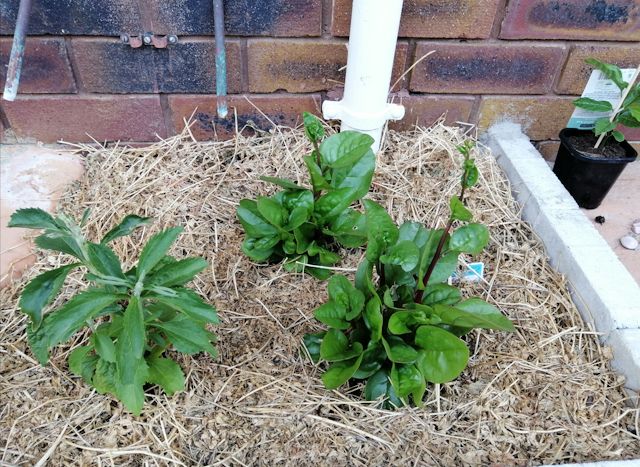
This is the red-stem variety. On the left is a Stevia Sweet Leaf, and
in the pot on the right is a Passionfuit plant waiting to be planted.
This morning I bolted a trellis onto the wall, to give the vine
something to grow up, but, fascinating, it also makes a great ground
cover:
https://www.youtube.com/watch?v=ZVT8tn4wcZw
Fascinating also, the entire plant is edible, apparently too, the berries, though one guy on youtube did say might pay to be cautious and not eat the unripe ones.
Stevia Sweet Leaf, scientific name Stevia rebaudiana, has edible
leaves and is a sugar substitute. Preliminary observation is that it is
not quite so happy in that hot spot -- it remains to be seen how it
copes with mid-summer. It was wilting a bit, so put lupin straw around
it to keep in the moisture. The Malabar, on the other hand, will
tolerate not only the heat, but also dry conditions.
Tags: general
Feijoa growth progress
Fascinating to watch. On the 5th October, I posted a picture of the Feijoa just starting to grow:
https://bkhome.org/news/202010/the-feijoa-has-started-budding.html
Took another photo yesterday, 16 days later:
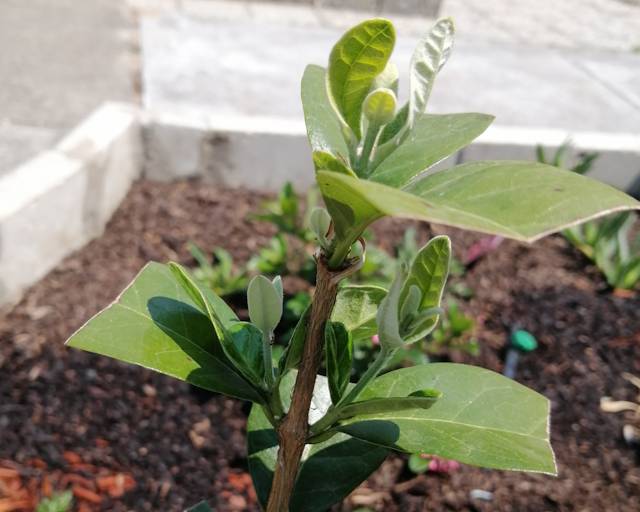
It is Spring here in the Southern Hemisphere, the plants are enjoying the sun and warm weather!
Tags: general
Yummy Blueberries
I buy Blueberries from supermarkets, and they are expensive, due
to the high cost of manual labour to pick them. So when I saw Blueberry
plants in my local plant nursery about 4 weeks ago, I thought, give them
a go, so bought two.
The variety is "Sunshine Blue" and although being very small already
had lots of unripe fruit when purchased. Here is a photo, taken today:
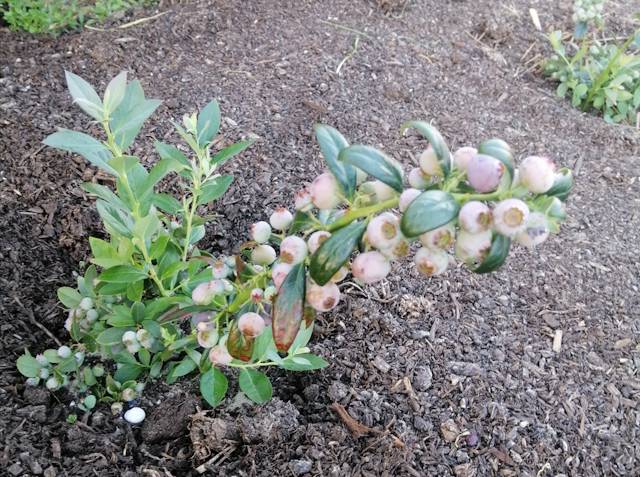
The stems covered in fruit are as I bought it, the stems without fruit are new growth.
Now, the most interesting thing, that prompted me to post this
report: the fruit doesn't all ripen at once. They ripen progressively.
Each day I have been going into the garden and picking a few that have
turned blue. Today picked five.
This is really great, as I will have a snack every day, apparently
over about 3-4 months. Sunshine Blue is a dwarf variety, "only" growing
to about 1.2 metres, but I am amazed to think about the abundance of
fruit on a plant that size.
Here is some information about Sunshine Blue:
https://www.gardenexpress.com.au/product/blueberry-sunshine-blue/
One of the key factors with this variety is that it will tolerate
less-acidic soil than most varieties of Blueberry. That's good, because I
didn't have a clue when planted them. Only afterward, read about the
acidity requirement, so scattered some potash of sulphur around them,
and some pine needles. They are growing, so must be reasonably happy
with the soil condition.
They are shallow-rooted, and I have drip irrigation, and have planted
them near the drippers. This will be another plant to report back on,
in say, another year.
Tags: general
The Feijoa has started budding
Yesterday I posted some "before photos", and there was a comment about the Feijoa not growing:
https://bkhome.org/news/202010/garden-before-photos.html
However, this morning I spotted budding!
The guy I bought the Feijoa from, had grown it from a cutting, and
had encouraged it to grow as a single stem. I told him that I wanted it
to be bushy rather than a tree, and he advised me to cut off the tip and
strip off all the leaves.
Well, I did cut off the top of the Fejijoa, but left the leaves - just cut them in half. Here is a photo taken this morning:
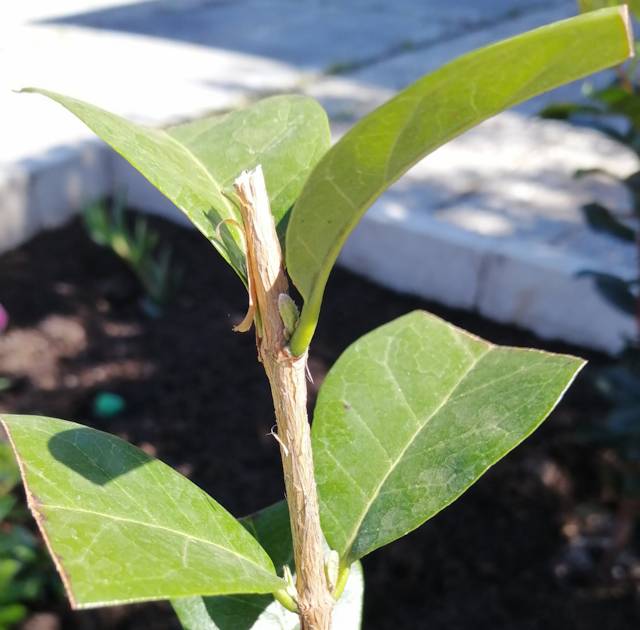
...almost every leaf has new buds. Fantastic.
Perth is located on a coastal sandplain, so the soil is not rich.
Well-drained though. Here is the photo that I posted yesterday:

...there is some mulch scattered around. The mulch is various kinds of tree bark I think.
Prior to planting I dug in some chicken and cow manure, and there is also some slow-release granules scattered around.
This morning I added about an inch of "premium mulch" from a local soil and garden supplies place, described as:
A MUSHROOM FARM COMPOST BASED MULCH, WITH PIG MANURE, STRAW, SAWDUST AND LIQUID MANURE. A FINE MULCH SUITABLE AS A COMPOST , SOIL CONDITIONER, AND AS A MULCH.
Keeping a small gap around the stem of each plant. However, what worries me is whether I have over-fertilised. Will soon find out I guess.In the above photo, bottom-right, you can see some small plants. These are Gazania Pink Kiss (Gazania splendens) seedlings:
https://www.floriana.com.au/natural-beauty/gazania/pink-kiss/
Tags: general
Garden before-photos
I posted about planting an Umbrella tree (Schefflera Amate) and an Irish Strawberry tree (Arbutus Undeo):
https://bkhome.org/news/202009/schefflera-amate-for-shaded-spot-in-garden.html
They were planted around the 11th of September, so have been in for
about 3 weeks. I think it would be nice to take some "before" photos,
then take photos again 12 months later. So, here they are...
This photo shows the two Umbrella trees:

For the first 3 weeks, they just sat there doing nothing, but today I
noticed new growth just starting. So, got inspired to take the "before"
photos. It will be very interesting to see what these plants look like
6, 12 months later.
Another one that I put in about the same time, was the Irish
Strawberry tree. It sat there doing nothing for about 2 weeks, then
started sprouting, quite vigorously. Photo:

...the new growth is lighter-green.
On the otherhand, a Feijoa tree, that I put in about the same time,
is doing nothing, it has lost some leaves (right side of photo). I am
wondering if the Feijoa will suddenly decide to "come good".
The Feijoa is also known as Pineapple Guava, though it is not a guava. According to here, it is fast growing to 4 metres:
https://www.gardensonline.com.au/gardenshed/PlantFinder/Show_1252.aspx
However, I have grown this before, and found it to be fairly slow
growing and only attained a low bush after several years.
Tags: general
Schefflera Amate for shaded spot in garden
I posted recently about searching for a screening plant suitable
for a spot in the garden that does not get direct sunlight for most of
the year:
https://bkhome.org/news/202009/screening-plant-for-fully-shaded-mediterranean-climate.html
I received some suggestions from David (Sage in the forums) and from
dogle. Dogle suggested the Irish Strawberry Tree, which was a case of
synchronicity, as I had just purchased one the day before. However, it
does seem that it wants more sunlight, so I planted it in a different
location in the garden.
I just stumbled across the Irish Strawberry Tree the day before
yesterday, while browsing through the plants section in Bunnings, and
recalled having read about it many years ago. It is fast growing, hardy,
can be pruned to a hedge, or grow into a small tree, and has edible
fruit.
The fruit is stated to be insipid by some online writers, however, as
dogle pointed out, it is necessary to wait until it is fully ripe and
then it has a nice taste. Information:
https://www.gardensonline.com.au/gardenshed/PlantFinder/Show_1519.aspx
Anyway, onto that fully-shaded spot. Today I found Schefflera Amate
in Bunnings, in the "Shade Plants" section, a small pot for AU$9.99.
Info:
https://www.gardensonline.com.au/gardenshed/PlantFinder/Show_2508.aspx

Will put it in tomorrow. What I need to do is take photos of this in a
year, then two years! Very interested to see how it turns out as a
screening plant in that spot.
Tags: general
Correct pressure for dripper irrigation
I thought that I will post about this, in case someone is
googling for information about installing a small dripper irrigation
system in their garden. They might find my experience useful.
It is just a small area, with ten Veri-Flow drippers and 13mm pipe. There is an automatic timer and pressure-reducer and filter:

Except that when first connected up, there was no pressure-reducer.
Result: those drippers sent jets of water up into the air higher than
me!
This surprised me, as I have put in dripper irrigation before, and
haven't used a pressure-reducer. However, they were in rural locations,
where the water pressure from the tap was quite low. At my current
premises, it is very high.
The Water Corporation in Western Australia states that they supply
pressure anywhere between 15mH (147kPa) and 100mH (980kPa). But I can't
find a figure for where I live.
The automatic timer is specified to work between 100kPa and 800kPa. This is it:
https://www.bunnings.com.au/holman-electronic-2-dial-tap-timer_p3120816
So I bought a combined pressure-reducer and filter, which is what you see in the above photo. Here it is:
https://www.bunnings.com.au/holman-13mm-pressure-reducer-and-filter-assembly_p3120097
Put it in, started the timer, ah, now the drippers have jets of water
"only" about 2-3 feet high! Very interesting. The Pope Veri-Flow
drippers are rated to be adjustable between 0-60 litres/hour -- well,
that "0" is wrong, they can't be screwed down enough to cut off the jet
of water.
So I examined the specifications of the pressure-reducer. It has
180kPa output. Very interesting, it means that the water from the tap
must be well above that, maybe in the order of twice.
Bunnings have a pressure-reducer rated at 100kPa output, that is a
direct screw replacement for the one I already have. So, off to Bunnings
again:
https://www.bunnings.com.au/pope-100kpa-pressure-poly-reducer_p3431632

That did the trick! So, the lesson learned here is that for a very
small dripper irrigation system, what we want is 100kPa. Perhaps with a
bigger system, with many more drippers or sprinklers, the flow through
the pipes would naturally reduce the pressure to something acceptable,
or perhaps a higher-rated pressure-reducer would be OK.
Or, if I was using sprinklers, and actually wanted large sprays of
water, then a pressure-reducer could have been dispensed with.
It was a fascinating little exercise.
Tags: general
Screening plant for fully-shaded Mediterranean climate
I have been having fun putting in some plants in the garden.
Standing at my front door and look to the side, I can see my neighbour's
front porch. What I would like is a screening plant, fairly dense,
about 1.8 metres (6ft) or thereabouts high. Problem is, that spot in the
garden is on the south side of the house, in the Southern hemisphere,
fully in shade for most of the year. In mid-summer, it will get some
sun, for part of the day.
I live on the outskirts of Perth, Western Australia, about 3km from
the coast, and the climate is mild, usually described as Mediterranean,
or similar to California, for example:
http://www.lookatwa.com.au/AboutPerth/climate.html
Today I put in drip irrigation, so can take care of keeping some
moisture in the soil over the upcoming summer. Interesting, the climate
in the South West of Australia has been changing, with more rain in the
summer:
https://phys.org/news/2016-03-southwest-australia-mediterranean-climate.html
...it is alarming that this has occurred over a small time-frame, just 16 years.
Anyway, I need to find a suitable screening plant, that will tolerate
having only indirect sunlight for most of the year. I want to be able
to prune it so as not to grow as high as the eaves of the house, and to
keep it dense. So far, I have settled on two possibilities, Sweet Box
(Sarcococca Confusa) and Dwarf Umbrella (Schefflera Arboricola).
Sweet Box
https://www.gardensonline.com.au/gardenshed/plantfinder/show_1925.aspx

Dwarf Umbrella
There are two completely different plants going by the common name of
Umbrella Tree. The one that interests me is Schefflera Arboricola,
native of Taiwan, which doesn't grow as tall.
https://www.gardensonline.com.au/gardenshed/PlantFinder/Show_1932.aspx
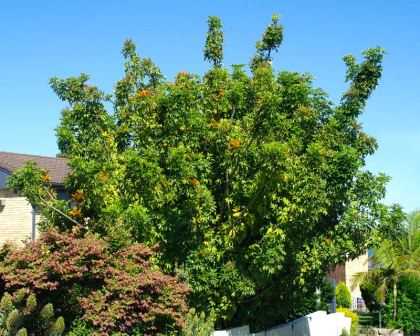
...hmm, that specimen is above the roof-line. I would have to prune
it to keep it at 6ft, and I wonder if that will turn out to be a
struggle, to keep it under control.
Haven't decided yet. Whatever is chosen, it will have to be available locally.
EDIT 2020-09-13:
I chose Schefflera Amate, see post:
https://bkhome.org/news/202009/schefflera-amate-for-shaded-spot-in-garden.html
Tags: general
